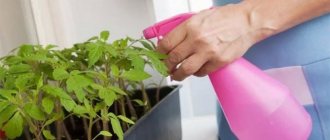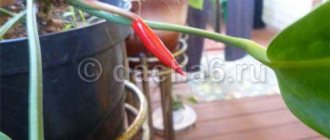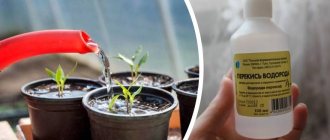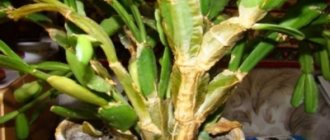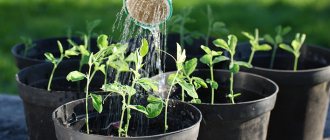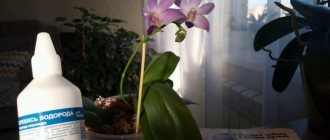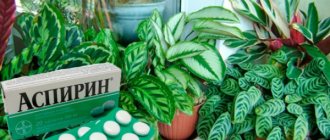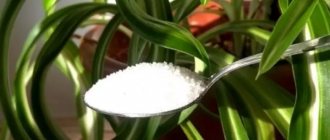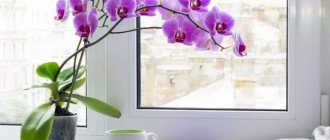One of the means for watering indoor flowers, which will help them bloom magnificently and for a long time, is hydrogen peroxide, diluted with water in the required proportion.
Dear readers!
For you, we have created communities on social networks in which useful articles and interesting ideas are published several times a day! Subscribe and receive useful content in a convenient format! Peroxide is available in almost every home, it is effective and practically harmless.
In this article we will tell you how to properly dilute hydrogen peroxide for watering indoor flowers, and also explain some of the nuances and subtleties of working with the substance.
What does hydrogen peroxide give to flowers and plants?
The chemical formula of water is H2O, and hydrogen peroxide or peroxide is H2O2 , i.e. one more oxygen atom for the same number of hydrogen atoms. It is the “extra” oxygen that is due to the main property of the substance – oxidation.
Due to the instability of the connection, upon contact with the ground, the oxygen atom goes into a free state. At the same time, the vital activity of microbes, as well as harmful microorganisms located in the soil, freezes. The process helps enrich the soil with oxygen and disinfect it.
Watering indoor flowers with peroxide water leads to:
- getting rid of harmful microorganisms that inhibit development and flowering;
- slowing down the process of root rotting;
- acceleration of bud formation and flowering;
- soil fertilization.
When foliage is damaged, hydrogen peroxide is used as a disinfectant.
Features of the substance
The hydrogen peroxide (peroxide) molecule contains the same atoms as the water molecule - hydrogen and oxygen, only there is 1 atom more oxygen. This makes the substance very close to water and plant friendly. It is this additional unit of oxygen that plays an important role in providing all the beneficial properties that gardeners use. It accelerates growth and gives rapid development.
Peroxide is an unstable substance; it quickly breaks down, releasing oxygen. It is the basis for many processes, an accelerator of various reactions.
For which indoor flowers is hydrogen peroxide a top dressing?
Hydrogen peroxide is found in rainwater, which indoor plants love so much. Therefore, peroxide is suitable for watering any indoor flowers.
IMPORTANT! For the use of a substance to be beneficial, its proportion in the working solution must be low. Otherwise you will harm your indoor flowers.
If for blooming and decorative flowers in good health, hydrogen peroxide is a good help for healthy growth and flowering, then for sick, wilting crops it is also a means of resuscitation.
Hydrogen peroxide can also be used for soaking seed material, treating the root system before transplanting or picking seedlings.
There is one caveat. Peroxide should be used with caution for watering domestic flowers with double leaves and inflorescences. For example, you cannot spray them, because this can lead to the onset of putrefactive processes.
You should also refrain from treating succulents, especially cacti, with hydrogen peroxide. These indoor pets are already very capricious in terms of watering. If you need to feed them, it is better to give preference to special complex formulations for succulents.
But orchids, aroids and arrowroot crops are very fond of watering with peroxide. All these are guests from the tropics, where tropical downpours often occur, so it is recommended to periodically water orchids, arrowroot, spathiphyllum, and anthurium with this product.
Where not to use
Hydrogen peroxide can be called a universal remedy, but there are species and crops that are undesirable to treat with it:
- Plants with double flowers, as their decorative properties may decrease.
- Species with pubescent foliage, since water is retained between the villi, and a putrefactive process may begin.
- All succulents, especially cacti.
Orchids, arrowroots, and aroids, on the contrary, will react to peroxide faster than all others. Watering crops such as violets and orchids can be done in the same way as with plain water - using the bottom method.
When can fertilizing be applied?
For young flowers, seedlings and individual seedlings, the peroxide mixture helps strengthen the root system and increases disease resistance.
Watering flowers with this fertilizer is especially useful during the growing season, when rapid growth and development occurs.
Fertilizing can be applied in combination with other natural fertilizers: sugar, honey, banana peels, etc. Watering with the solution is carried out the day before or after applying the main fertilizer.
Feeding seedlings during diving strengthens and protects their root system.
Fighting diseases of aquarium plants
There is a lot of debate about what a medicinal product does for plants in an aquarium and whether it is safe to use for fish. Researchers who have tested the effects of several methods in a living, functioning aquarium note the following:
- the treatment is effective in treating oxygen deficiency in fish;
- a week-long course allows you to get rid of indestructible green algae, including black beard;
- The nitrogen released during the decomposition of organic matter can be neutralized, preventing fish diseases.
To get a positive effect and not harm the inhabitants, peroxide is used according to the following scheme:
- the minimum dosage agent (3%) is drawn into a syringe in a volume of 2.5 ml;
- pour the contents of the syringe into clean, warm water prepared for the aquarium and stir;
- The product is added to the aquarium when changing the water; to do this, pour it in a thin stream onto a working filter for maximum even distribution;
- after 60-90 minutes, green algae (plaque on the walls and aquarium plants) begin to die, at this time the soil needs to be siphoned and the required amount of clean water added to the aquarium.
Recommendation. Unfortunately, to remove all the green deposits on the glass, you will have to work hard for a week. Daily peroxide treatments will be required. To prevent a recurrence of such a negative phenomenon, it is recommended to increase lighting, normalize aeration and filtration of water, and not skip the time for replacing it.
How to use peroxide for flowers
Watering indoor plants is often done with tap water, which contains calcium and magnesium salts. Such hard water negatively affects flowers. Therefore it is softened.
For this purpose, make a mixture of 3% hydrogen peroxide and water in various proportions. The concentration of the mixture depends on the purpose for which it will be used: watering, spraying, treating seeds and seedlings, etc.
ATTENTION! The main ingredient is hydrogen peroxide, the concentration should be 3%.
The condition of the plant and soil is an important factor when watering with this product.
Improper use of the drug can cause damage to flowers, sometimes irreparable.
Benefit
Hydrogen peroxide works in several ways at once:
- disrupts the normal life cycle of microbes;
- stops the development of fungi and bacteria;
- reduces the risk of root rot;
- accelerates the development of indoor plants;
- improves bud formation;
- allows you to remove pesticides;
- removes chlorides from water;
- serves as an activator of seed germination.
In addition, for damaged parts it acts as a disinfectant and means for rapid recovery.
How to water with a solution: proportions and step-by-step instructions
Using the drug, water is purified from impurities and chlorine. The watering solution is prepared at the rate of 1 tablespoon of hydrogen peroxide per 1 liter of water. Water once every 5-7 days. For regular use, just add 2 drops of the product to a liter of water.
It is first necessary to clear the surface of the earth from fallen leaves and debris to avoid the development of rotting. The watering process is carried out as follows:
- purchase 3% hydrogen peroxide at the pharmacy;
- measure out 1 liter of settled lukewarm water;
- add the required amount of the drug to the water, mix thoroughly;
- moderately water the indoor flower. The proportion of added liquid must be calculated in accordance with the size of the home flower.
The water should flow along the edge of the pot so as not to erode the soil near the root.
The second recipe is with sugar. In addition to oxygen, home flowers will receive glucose, which will help plants grow and develop better.
The fertilizer should be prepared according to this recipe:
- Stir half a glass of sugar into 100 ml of hydrogen peroxide. It is necessary to bring the mass to a homogeneous consistency.
- Pour the mixture with 2 liters of warm water. Stir thoroughly.
- Water the plants, calculating the proportions in accordance with the size of the home flower.
The drug can also be used to moisten the soil daily, but then the proportions will be completely different.
Only 3 drops of the drug are needed per liter of warm, settled water.
If you are planning to replant an indoor flower, you can saturate the soil with oxygen by using the following mixture: 1 liter of water + 6 ml of hydrogen peroxide.
Application for seed germination
Treatment of seeds with hydrogen peroxide is carried out to remove possible viruses, bacteria, spores of dangerous fungal diseases that can damage the sprout as soon as it leaves the seed coat. The medical product has strong disinfectant properties and works as an oxidizing agent. The principle of influencing bacteria is an effective formula of oxygen, the molecules of which are released when they enter the active medium. The peroxide composition breaks down into oxygen and ordinary water. Thanks to this, the product does not harm plants at any stage of development (seeds, sprouts, seedlings, adult specimens).
Methods of application
- A solution of 3% peroxide is heated to body temperature (it is advisable to place the bottle in a container with hot water for a minute, shake and heat for another 30 seconds), place seeds in it, leave for 10 minutes and lay out on a clean cloth to dry.
- The required amount of the drug is poured into a spray bottle at a dosage of 10%, the seeds are sprayed, then allowed to dry naturally.
- Reviews from gardeners talk about the experience of soaking seeds for 12 hours in a 10% composition in a ratio of 1/1 with the number of seeds (tomatoes, eggplants and beets are kept for 24 hours), then washed and dried.
On a note. It is better to lay out the planting material on a surface made of natural glass or ceramics; H2O2 reacts with metal.
Growth stimulator for seeds
Seeds treated with peroxide before planting receive additional protection from pests and stimulation for active growth. This is explained by a decrease in the effect of natural inhibitors (protective mechanisms of the seed). In the natural environment, inhibitors are removed naturally through oxidation in the soil, much more slowly than when using peroxide.
On a note. Summer residents often use Epin as an expensive stimulant (in various versions - “extra”, “forte”). It is not advisable to combine Epin with peroxide. The drugs may react and give unexpected effects. According to the observations of gardeners, peroxide gives a similar result, but is cheaper.
How to spray flowers with a solution, how to dilute it?
In winter, when the air in the apartment is dry, after moistening, the color of the foliage becomes bright and saturated. For spraying, use the same composition as for watering: 1 tablespoon of peroxide per liter of liquid. For effectiveness, it is recommended to add a teaspoon of sugar.
Sick plants are sprayed with a mixture: 2 tablespoons of the drug per liter of water + 2 drops of iodine, and to control pests, alcohol is added instead of iodine.
Also, a solution with added iodine is used to control pests (scale insects, aphids and mealybugs).
The recipe is as follows: 0.5 liters of water, 1 teaspoon of peroxide and 10 drops of iodine. Everything is thoroughly mixed and poured into a spray bottle.
Hydrogen peroxide and alcohol, mixed in a certain proportion, will rid your home flowers not only of pests, but also of diseases.
The working solution is prepared as follows: 0.5 liters of water, 25 ml of peroxide and 10 ml of medical alcohol. Spraying is carried out every day for a week.
First spray the underside of the leaves, then the top. We must try to moisten the stems and shoots, and also ensure that moisture does not get on the flowers and buds.
IMPORTANT! You cannot spray plants with velvety, translucent and thin leaves: violets, caladium, pelargonium, etc.
In what cases should peroxide not be used?
Some people have negative views about using peroxide on flowers. This is an unfounded subjective opinion, since no harm has been found from the use of peroxide. As mentioned above, peroxide is harmful to plants only in excessive doses. It should not be used frequently in large quantities. The more often you use it, the lower the dosage. For daily use, the dosage is minimal. As a top dressing, the dose of peroxide is increased. If the plant is sick, then the amount of peroxide in the water is added even more. But after carrying out medical procedures, you should stop using peroxide for a while.
The peroxide substance should not be used in high dosages or for other purposes. Do not use old solution. You always need to make a fresh composition.
Important! Peroxide does not help with serious plant disease or pest infestation. In this case, drastic measures with the use of potent drugs are required.
Advantages and disadvantages of hydrogen peroxide
The use of the drug, subject to all rules and regulations, gives good results in caring for indoor vegetation. With its help you can cope with diseases, pests, and feed flowers. Peroxide serves to stimulate growth and flowering.
But positive properties can turn into negative ones.
When the proportions in the solution are not respected, the roots can be burned, or the leaves will begin to become stained.
If watered too frequently with the solution, an indoor flower may lose its natural immunity, and then it will not be able to independently protect itself from diseases. As a result, the flower grows “spoiled,” which is contrary to nature.
Application of fertilizer solution
This is the hydrogen peroxide you should use.
Using the solution as an independent fertilizer gives good results. Systematic irrigation with the described solution allows you to improve the structure of the soil mixture and increase the digestibility of nutrients.
After just a few waterings, an improvement in the above-ground part of the plant is noticeable: the shade becomes richer, the foliage and branches are more elastic.
It is not recommended to use synthetic fertilizers in parallel. From time to time you can enrich the soil in the flowerpot with natural nutrient mixtures or replace the soil with new one.
How does the substance affect the plant?
The drug has bactericidal and disinfectant properties and for vegetation it is:
- growth and flowering accelerator;
- medicine against diseases;
- a means to combat harmful insects;
- immunostimulant;
- disinfectant.
The substance in the correct proportion is harmless, therefore it does not poison plants with chemicals. When a flower is weakened or damaged, the peroxide solution acts gently, without the risk of harming the already withering plant.
REFERENCE. Hydrogen peroxide is an effective remedy that helps in caring for indoor plants. Its correct and timely use has a beneficial effect on flowers. Watering with this preparation does not require any special skills and can be done even by inexperienced gardeners.
Reviews from flower growers
Svetlana: “On the recommendation of an experienced gardener, I decided to treat the orchid roots with a bactericidal peroxide composition. After a week, the rhizome became stronger and the white moldy coating disappeared. Previously, using various store-bought fertilizers, I had not noticed such a quick effect. I don’t know how it works with other plants, but in the case of orchids it definitely works.”
Vladimir: “My wife constantly has spider mites in her flowers. No matter what she tried, the results only lasted for a short time. She read on the Internet that you can get rid of such pests with a solution of peroxide and iodine. He says there are fewer ticks. In a week he will try again to treat it until it disappears completely. The product is inexpensive, and the results are visible immediately.”
Irina: “I use a weak peroxide solution for spraying when the leaves turn yellow. I apply it at the very beginning of their yellowing so that it will definitely work. I haven’t tried watering flowers with the solution yet, but I think the effect will be no worse than from store-bought fertilizers.”
5/5 — (2 votes)
Common Mistakes
Often, beginning flower growers, in order to save money, leave the prepared mixture for the next use.
ATTENTION! The hydrogen peroxide mixture is prepared immediately before watering and will be used immediately. Unused residue quickly decomposes, losing its beneficial properties.
Another mistake is the incorrect proportion of solution components. Exact adherence to proportions guarantees the beneficial qualities of the drug.
Next error: the concentration of the solution does not correspond to the purposes for which it was prepared.
For example, a mixture is prepared to treat a plant, and is used for regular watering.
Additional benefits
It is worth remembering that this option of fertilizing eliminates the need to apply additional fertilizing , since the prepared composition contains all the necessary elements.
If you add 40 drops of iodine to the described solution, you can protect flowers from a number of pests - scale insects, midges, mealybugs and spider mites.
In case of large-scale damage, it is recommended to add a little medical alcohol to the last version of the composition. In a weaker concentration, this mixture is good for the prevention and disinfection of healthy plants.
This video contains some more useful tips on using peroxide:
A big advantage of hydrogen peroxide when treating indoor and garden plants is its availability and low cost. And most importantly, no aggressive chemicals!
Answers to frequently asked questions
Is it possible to water indoor flowers with hydrogen peroxide?
If in doubt, you can conduct an experiment: water one flower. When you get satisfactory results, all doubts and fears will disappear.
What diseases can be treated with hydrogen peroxide?
Based on the bactericidal and antiseptic properties of this product, fungal diseases and mold damage can be cured.
The initial stages of the disease are treatable. At the same time, peroxide is a powerful preventative against these diseases.
What are the benefits of fertilizing plants?
Due to its non-toxicity, low cost and ease of preparation, hydrogen peroxide is widely used in plant growing. Hydrogen peroxide can be used to feed both seedlings for the garden and indoor flowers. Peroxide will have a particularly beneficial effect on weakened plants whose roots have suffered from excessive watering.
Hydrogen peroxide has a positive effect on plant growth
Beneficial features:
- the product densely saturates the soil with oxygen, which helps protect the roots of the plant from rotting;
- has a mild fungicidal and bactericidal effect;
- accelerates flowering;
- stimulates the development of the root system;
- supplies plants with nutrients.
Spraying
Peroxide is used in the form of an aqueous solution for pollination, fertilizer, and treatment of plants. The usual composition of a liter of water and a spoon of peroxide is poured into a spray bottle and used as follows:
- for spraying coniferous trees and shrubs in order to improve pollination and increase the ability to reproduce;
- for treating garden crops against late blight (add a spoonful of 96% alcohol to the main solution);
- for spraying plants and indoor flowers with the addition of phosphate fertilizer for foliar feeding.
Characteristic features and properties of the product
Before using hydrogen peroxide for the garden, let's study its properties in all areas of human life. If we consider the household, most housewives use the liquid to bleach fabrics, heal and treat wounds and cuts.
Some people use peroxide as a base for removing permanent hair dye. Hairdressers do the same when there is a need to repaint a client in a different, lighter tone. But how did a medical product move into the categories of fertilizers for flowers and plants?
Peroxide has the chemical formula – H2O2. Research by scientists has shown that the liquid has a positive effect on any living creature. Including the plant. The main advantage of the liquid is oxidation.
This means it can have a detrimental effect on the development of pathogenic microorganisms. Feeding with peroxide will help quickly restore the plant’s immunity and eliminate development problems.
There are no taste qualities. Smell and color also do not exist. Pharmacy version - 3% substance. For hairdressing services, 9% applies. This option is not suitable for gardening and gardening treatments.
The dosage for use is individual for each plant. Reason: when diluted with 3% water, peroxide is replenished with an additional oxygen atom.
But it is quickly lost and easily aerates in the soil. But the positive characteristics of the drug do not end there. This is an excellent antiseptic that can disinfect and cleanse most types of germs. Healing occurs immediately. Another advantage is the complete absence of toxicity.
